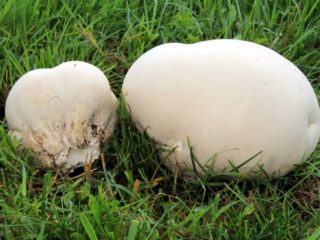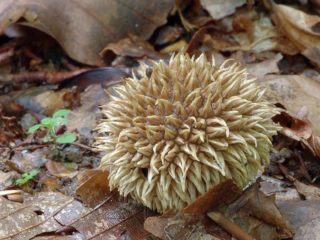Content
- 1 Description of the pear-shaped raincoat
- 2 Doubles and their differences
- 3 Where and how does the pear-shaped puffball grow?
- 4 Is the pear-shaped mushroom edible or not?
- 5 How to make pear-shaped raincoats
- 6 The healing properties of pear-shaped raincoats
- 7 Is it possible to grow pear-shaped raincoats on the site?
- 8 Conclusion
Pear-shaped raincoat is one of the most common representatives of the extensive genus of Raincoats, belonging to the Champignonaceae family.The pulp of a young mushroom, which has not yet darkened, is absolutely edible, but at an old age it is unsuitable for food. Often, mushroom pickers undeservedly ignore pear-shaped raincoats, preferring to collect more “thoroughbred” gifts of the forest during the season. However, they are wrong: the young fruiting bodies of this mushroom can be fried and boiled, stewed, dried or frozen for the winter. Dishes made from young pear-shaped raincoat taste excellent. In addition, this mushroom is known for a number of properties beneficial to human health. If you wish, you can try to purposefully grow a pear-shaped raincoat on your own plot.
Description of the pear-shaped raincoat
The fruiting body of the pear-shaped puffball is a white ball, narrowed downward, in shape really reminiscent of an inverted pear or a golf ball sitting on a short false stem. Often the “pseudopod”, tightly fused with the upper part, is completely hidden in the moss, which is why the mushroom may seem completely round. The sizes of representatives of this type of raincoat are quite small: they usually reach 2-4 cm in height, and the diameter of their most voluminous part ranges from 3 to 7 cm.

Pear-shaped raincoat is easy to find in our forests after warm rains
The color of the young mushroom is very light, almost white. With age it darkens, gradually becoming dirty brown. As the pear-shaped puffball grows, the structure of its surface also changes. In young organisms it is granular, covered with outgrowths in the form of small, non-sharp spines. In older fruiting bodies, the surface becomes smooth, but often a large mesh appears on it, hinting at cracking of the thick outer skin.If the mushroom is not young, it can be easily peeled off, like the shell of a boiled egg.
The flesh of young pear-shaped raincoats is white, less often cream-colored, and its consistency resembles dense cotton wool. It is quite edible, has a mild taste and a pleasant mushroom aroma. Over time, it becomes darker, acquiring a reddish-brown color, and turns into spores, changing the structure to loose, and then to powdery. At the top of the mushroom, which is fully ripe, a hole opens through which the spore powder spills out and scatters in the wind. Old pear-shaped puffballs are not suitable for human consumption.
Doubles and their differences
The pear-shaped raincoat is quite difficult to confuse with other types of raincoats. It is characterized by a well-defined “pseudopod”, as well as its growth characteristics - it is usually present in large, close “families” on rotting wood. This mushroom has no obvious counterparts.
However, one can find a certain similarity between pear-shaped and ragged raincoats. The latter is also an edible mushroom. Its entire surface is covered with white flakes resembling cotton wool. The color of its fruiting body varies from light cream to reddish brown. This mushroom grows in small groups or singly. It is found exclusively in oak and hornbeam groves with a warm climate, while its pear-shaped “brother” can be found without much difficulty in any deciduous and mixed forests.
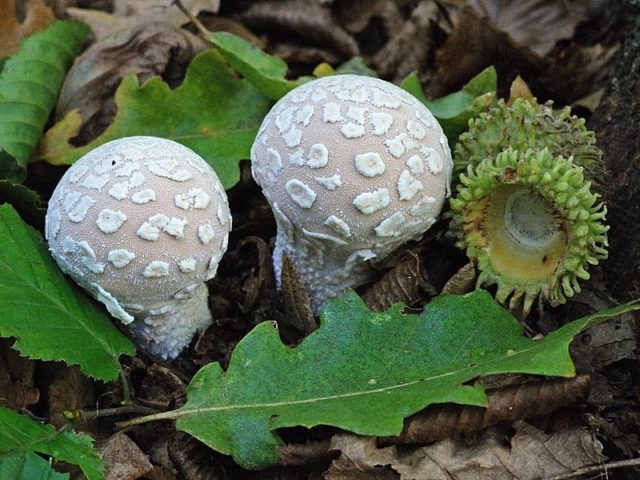
The ragged puffball is distinguished by characteristic “flakes” on the outer skin
Another edible type of puffball, which is sometimes confused with the pear-shaped one, is baggy bighead. It is distinguished by its relatively large size (the diameter of the thickened part is 10-15 cm), as well as its characteristic shape, slightly flattened on top. The surface of this mushroom is fine-grained, covered with well-defined cracks. The baggy golovach can be found in small groups or alone in meadows, clearings, and forest edges.
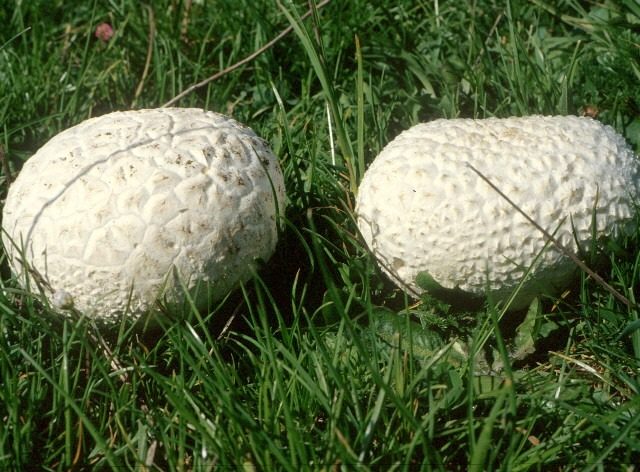
The baggy loggerhead is larger in size and looks slightly “flattened” on top
In addition, you should know that in nature there are several species of false raincoats, united in the genus Scleroderma. These mushrooms are inedible, and although they are not directly classified as poisonous, if eaten in large quantities they can cause poisoning or intestinal upset.
It is not difficult to distinguish scleroderma from edible puffball. These mushrooms usually grow in “nests” of several pieces. The skin of the false type is usually thick, dense, covered with small scales or warty growths. It may also have small cracks. The color of the skin of scleroderma is usually yellowish or ocher, and the color of the flesh even in a young mushroom is yellowish or olive. Sometimes you can discern a “marble” pattern on it, which is formed by light veins. As the scleroderma fruiting body matures, its central part noticeably darkens, first acquiring a gray-violet, then almost black tint. The pulp of mature puffballs retains a dense structure. The smell of these mushrooms is usually pungent and unpleasant.
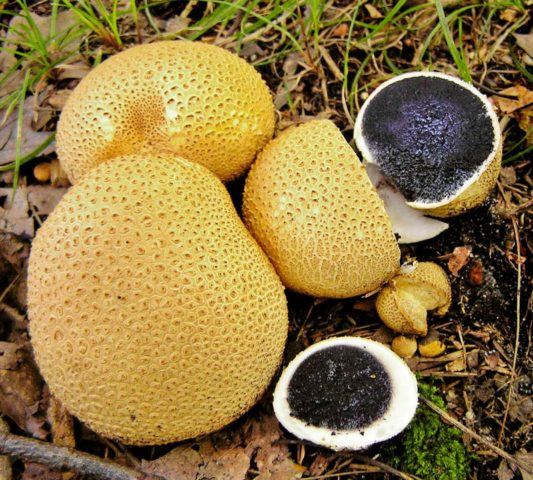
Scleroderma vulgaris is a false puffball
Where and how does the pear-shaped puffball grow?
The pear-shaped raincoat is found almost everywhere in Russia from the beginning of July to the end of September. It can be found in deciduous or mixed forests, gardens and parks on rotten wood - mossy trunks of old trees, rotten stumps. Sometimes the remains of a tree can be buried in the ground where these mushrooms are found. Pear-shaped puffballs usually grow in large groups.
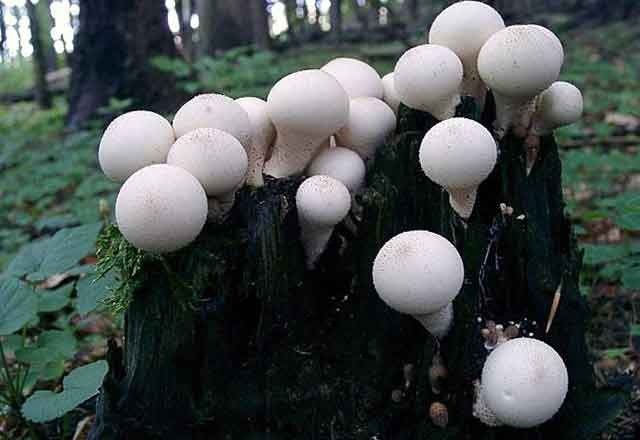
To grow and develop, the pear-shaped puffball requires rotten wood.
Where in the forest you can find this mushroom and what it looks like, the video explains in detail:
Is the pear-shaped mushroom edible or not?
Young specimens of pear-shaped raincoat with dense and white flesh are considered quite edible. The range of their use in cooking is wide: most often they are dried, but they are often fried, stewed and grilled, and also frozen for future use. These mushrooms tolerate heat treatment very well - they practically do not boil down and do not become too jelly-like or soft.
However, everything said above applies only to young raincoats. Once the flesh of the mushroom begins to darken as it matures, it is no longer suitable for consumption.
Their fruiting bodies are capable of absorbing harmful substances from air and water and accumulating them for a long time.
How to make pear-shaped raincoats
Raincoats, including the pear-shaped one, are actually not very popular among mushroom pickers. However, this attitude towards them is unfair. Young pear-shaped puffballs will make wonderful tasty dishes if you prepare the mushrooms correctly and use proven recipes.
Cleaning and preparing mushrooms
Pre-treatment of pear-shaped puffball is not difficult. It includes the following steps:
- Thoroughly rinse the mushrooms in clean water. Particular attention should be paid to the round “hat”, which must be carefully cleaned of dirt and adhering debris, as well as rough particles of skin.
- Next, you need to clean the raincoats from the top skin. It should be picked up with a convenient knife and carefully removed.
- After this, the mushrooms need to be chopped. Small ones are divided in half, large ones - into more parts. If areas damaged by worms are found, they must be cut out.
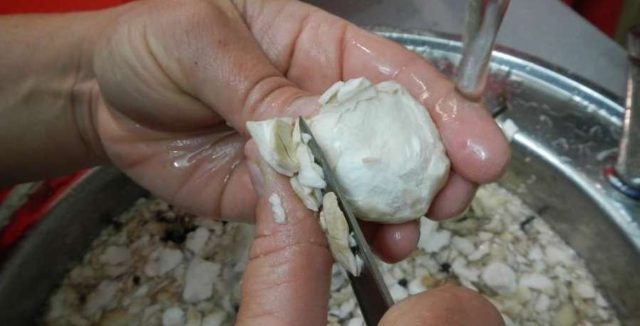
Pre-treatment of pear-shaped raincoat includes rinsing and cleaning
How to fry
Many people believe that pear-shaped puffballs are most delicious when fried. They make an excellent roast with a mushroom flavor that can be served with a variety of sauces and side dishes.
Pear-shaped raincoat | 0.4 kg |
Onion (large) | 1 PC. |
Garlic (cloves) | 2-3 pcs. |
Salt | taste |
Sunflower oil for frying |
|
Preparation:
- Rinse the pear-shaped raincoats well under water and remove the tough outer skin. If necessary, cut into pieces of the desired size.
- Heat oil in a frying pan and add mushrooms. Fry, stirring, over high heat until the contents are browned.
- During frying, add onion, cut into small pieces. Salt the dish.
- At the end of cooking, add crushed garlic and mix well.
- It is recommended to serve the dish hot, first sprinkled with herbs.

The taste of fried pear-shaped puffball is incomparable
How to dry
Drying pear-shaped puffballs is the most popular way to prepare them. It is believed that this mushroom tastes better when dried than when boiled. Raincoats prepared in this way can be ground into powder and later added to the base of sauces and first courses. In particular, the broth made from dried mushrooms of this type is very tender and aromatic.
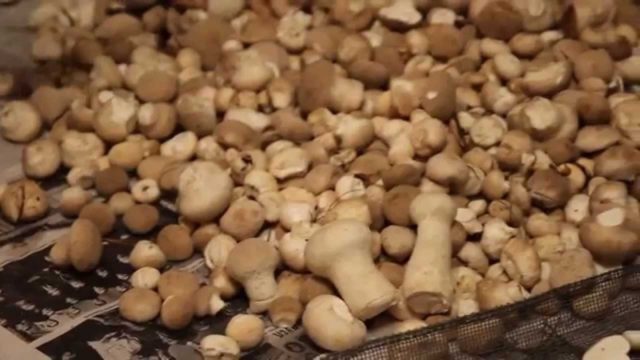
Dried puffballs make excellent first courses and sauces.
To dry pear-shaped raincoats, they need to be washed and cleaned, removing the hard skin. If necessary, cut large specimens into several pieces. Then you should choose the most convenient drying method:
- Place the mushrooms on a wire rack and place in the oven, preheated to 45°C, gradually increasing the temperature to 60°C. The oven door should be kept ajar. Total cooking time is about 3 hours.
- Thread the mushrooms onto strong threads or place them in a single layer on wide baking sheets lined with baking parchment and place them in the fresh air in a place well lit by the sun. At night, it is advisable to place the baking sheets in a dry, ventilated area. In this case, the drying time will take several days.
- You can use an electric dryer. Raincoats should be cut into plates no more than 1 cm thick, placed on a metal tray to dry, set the temperature to about 70 °C and leave for 6-8 hours.
How to freeze
Freezing pear-shaped puffballs allows you to preserve their taste, shape, aroma, and texture for a long time.The resulting semi-finished product is then used for the same dishes that can be prepared from fresh mushrooms.
In order to freeze pear-shaped raincoats, you need to:
- rinse fresh mushrooms;
- select those whose flesh is white and carefully wipe with paper towels;
- cut them into thin slices, distribute them into freezer bags or containers and put them in the freezer compartment of the refrigerator.
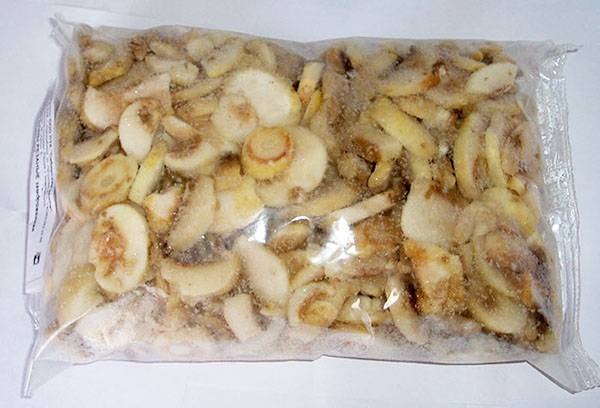
Frozen mushrooms are best stored in special bags
How to preserve pear-shaped raincoats for the winter
Another way to preserve pear-shaped puffballs for future use is by preserving them in a marinade. These mushrooms make an excellent homemade preparation, which you can try in just 4-5 days.
Pear-shaped raincoats | 2 l (already boiled mushrooms) |
Salt | 2 tbsp. l. |
Sugar | 1-1.5 tbsp. l. |
Dill seeds | 1 tsp. |
Black pepper (peas) | 0.5-1 tsp. |
Carnation | 2-3 pcs. |
Garlic (cloves) | 3 pcs. |
Vinegar (9%) | 4 tbsp. l. |
Preparation:
- Sort through the raincoats, preferably cutting each one in half. Select young specimens with white flesh.
- Soak them in cool water for 20 minutes. Then rinse thoroughly and transfer to a saucepan, filling to the top with clean water.
- Place on the fire, wait until it boils and cook for 15-20 minutes.
- Add spices and spices. Keep on fire for another 10 minutes.
- Remove from stove. Pour in vinegar.
- Place into pre-prepared sterile half-liter jars. Add a little vegetable oil to each of them. Cover with parchment sheets and tie with twine.
- After cooling, place the workpiece in a cold place - a cellar or refrigerator.
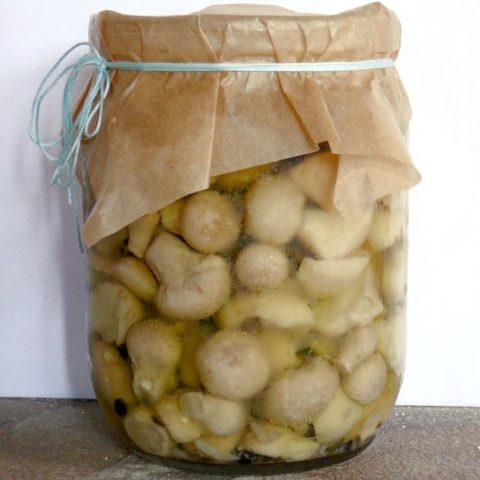
Raincoats in marinade - excellent preparation for future use
Other recipes for making pear-shaped raincoats
There are other ways to deliciously prepare pear-shaped raincoats without spending a lot of time and effort. For example, these mushrooms will turn out great if you first marinate them in homemade mayonnaise and then bake them in the oven under a golden cheese crust.
Pear-shaped raincoats | 1 kg |
Onion | 0.2 kg |
Hard cheese | 0.3 kg |
Mayonnaise (homemade) | 5 tbsp. l. |
Vegetable oil | 3 tbsp. l. |
Salt, pepper, dill | taste |
Preparation:
- Cut the cleaned and washed young pear-shaped raincoats into pieces and place in an enamel bowl.
- Add onion, cut into halves of rings.
- Mix mayonnaise with oil, salt and pepper.
- Pour the resulting marinade over the mushrooms and onions and leave for about 1 hour.
- Meanwhile, chop the cheese (grate it on a beetroot grater).
- Cover a baking sheet with foil and lightly grease with vegetable oil. Add the pickled mushrooms, cover with another sheet of foil and bake for half an hour.
- Unfold the foil, sprinkle the mushrooms with grated cheese and return to the oven for another 10 minutes.
- Sprinkle the finished dish with chopped herbs before serving.
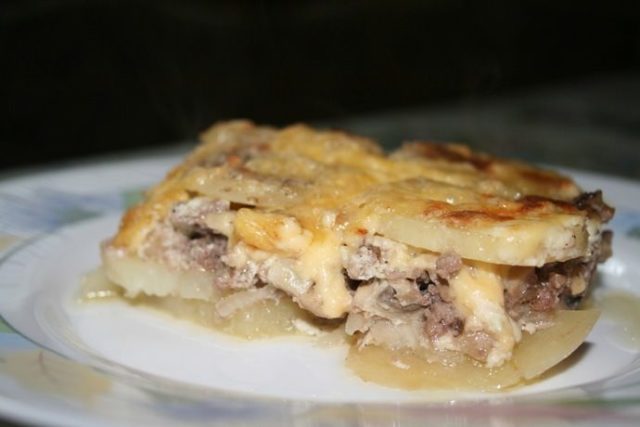
Pear-shaped raincoats baked in the oven with cheese can be prepared without difficulty
Pear-shaped puffballs stewed in sour cream along with boiled potatoes and onions will be very tasty, satisfying and aromatic.
Pear-shaped raincoats | 0.5 kg |
Potato | 0.3 kg |
Onion | 2 pcs. (average) |
Low-fat sour cream | 0.2 kg |
Salt pepper | Taste |
Vegetable oil for frying |
|
Preparation:
- Peel and boil the potato tubers, adding salt to the water first.
- Fry prepared (washed and cleaned) pear-shaped raincoats in vegetable oil for about 25 minutes.
- Separately, fry the onion until golden brown.
- Combine mushrooms and onions. Add salt, pepper and fry for another 15 minutes.
- 5 minutes before readiness, add sour cream and mix well.
- Cover the dish with a lid and simmer for 7-10 minutes, reducing the heat to low.

Raincoats stewed in sour cream with potatoes and onions - an excellent option for a tasty and satisfying second course
The healing properties of pear-shaped raincoats
Preparations from the spores and fruiting bodies of the pear-shaped puffball are widely used in folk medicine as a means to treat a number of diseases. The composition of this mushroom is extremely rich in bioactive components, enzymes, amino acids, micro- and macroelements, which allows it to be used for medicinal and cosmetic purposes.
The benefits of a pear-shaped raincoat are as follows:
- its pulp has the ability to absorb and remove heavy metal salts, radionuclides and toxic substances from the body;
- calvacin, which is part of this mushroom, is known for its anticancer properties, suppressing the growth of malignant tumors;
- it is used as a natural antibiotic that reduces the activity of a number of pathogenic bacteria, in particular the tuberculosis bacillus;
- raincoats are used to treat frostbite and ulcers by cutting fresh mushrooms into thin slices and applying to the affected areas;
- eating this mushroom helps strengthen the human immune system, improves the functioning of the heart and blood vessels, and helps with diseases of the stomach and intestines;
- dried raincoat powder is used as a pain reliever and a blood stopper;
- Preparations from its spores are used to treat diabetes, bronchial asthma, adrenal gland diseases, hypertension, and pleurisy.
They help against diseases of a number of organs - in particular the stomach, kidneys and liver. They are also used externally to get rid of skin diseases and disinfect wounds.
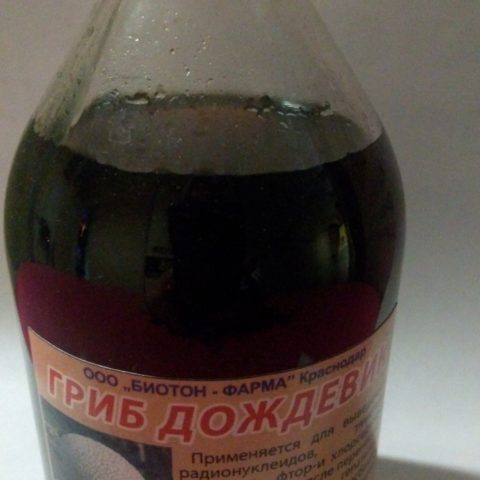
Alcohol tinctures of pear-shaped puffball are used in folk medicine as a remedy for many diseases.
Is it possible to grow pear-shaped raincoats on the site?
Little is known about growing pear-shaped raincoat at home, but the possibility exists. The basis for creating a bed with these mushrooms on your own plot can be the mycelium of puffballs, purchased ready-made, or a self-made solution containing their spores.
To prepare such a solution, you will need to collect mature raincoats. They should be finely chopped, pour cold water and leave for several days, stirring from time to time.
Next you need to prepare the bed. The area for growing pear-shaped raincoat in the country should be in the shade of trees or protected by an artificial canopy from direct sunlight. You need to dig a trench in it about 2 m wide and at least 30 cm deep. It is recommended to fill it with a mixture of poplar, birch or aspen leaves, on top of which to lay the branches of these trees. The layers should be compacted tightly so that their thickness is no more than 20 cm. They should be watered with water, and then soil should be added in a layer of about 5 cm.After this, raincoat mycelium is scattered over the entire area of the trench or a solution with spores is sprayed, the future bed is drip-watered and covered with branches.

If you wish, you can try to grow raincoats on your own plot
It is necessary to ensure that the soil in the garden bed does not dry out, watering it periodically. Even a slight excess of moisture is acceptable.
After the mycelium germinates, it is advisable to carefully mulch the area with last year’s leaves.
Conclusion
Pear-shaped puffball is a very common mushroom in Russian forests, appearing after warm rains. It is considered to be conditionally edible. Young specimens, the flesh of which is still white and dense, are quite edible. From them you can prepare a large number of delicious dishes and preparations for future use. Ripe mushrooms lose this property: their fruiting body darkens and turns into spores, so they cannot be cooked. In addition, pear-shaped puffball has medicinal properties and has long been used in folk medicine. It is known that, with some effort, you can try to grow a plantation of such mushrooms artificially in your own garden.


